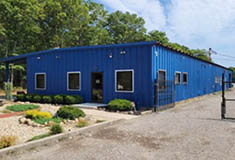Robust Long Island office and industrial sectors continue to bolster a strong market - by Lee Rosner
 Coldwell Banker Commercial Island Corporate Services is pleased to present Long Island’s office and industrial market reports for the third quarter of 2019, compiled using CoStar Property statistics. Relatively low unemployment and healthy incomes on Long Island reflect office and industrial market stability. Long Island’s economy is heavily reliant on the well-being of the greater New York economy, yet the metro has unique strengths that continue to bolster its strong market.
Coldwell Banker Commercial Island Corporate Services is pleased to present Long Island’s office and industrial market reports for the third quarter of 2019, compiled using CoStar Property statistics. Relatively low unemployment and healthy incomes on Long Island reflect office and industrial market stability. Long Island’s economy is heavily reliant on the well-being of the greater New York economy, yet the metro has unique strengths that continue to bolster its strong market.
Office Market
Office properties in the Long Island Metro Area focus on accessibility for companies and residents alike. With low volatility comes a lack of explosive potential, and only a handful of large deliveries have occurred in this cycle. Yet, the market attracts consistent local demand with minimum new supply, allowing vacancies to reach the lowest levels in almost two decades. The vacancy rate in the third quarter slightly increased from last quarter’s 6.4% to 6.5%, with no annual percent change. While strong positive net absorption compressed vacancies throughout much of 2018, the metro’s vacancy rate has reversed course over the past two years. Vacant sublease space had a -24% annual change at 520,244 s/f. Large-block move-outs outpaced new tenant move-ins thus far in 2019, causing net absorption to decrease dramatically from the second quarter at 181,785 to negative (72,779). Despite the recent deceleration, the metro’s occupancies remain strong overall, well above the national rate.
Long Island’s rent growth continues to trail the national average. Rents are higher on average in Nassau County than in Suffolk County due to Nassau’s proximity to NYC, which boasts a higher population count and office market. Additionally, transit options are more plentiful in Nassau, which is key for firms looking to attract employees. Six of the top seven highest rent submarkets are in Nassau, with Eastern Suffolk being the lone exception. Western Nassau has the highest asking rents at approximately $33 per s/f on average. Total rental rates are steadily rising at $28.40 per s/f, up 1% from the third quarter 2018. Class A and B rental rates per s/f continued to climb at $31.97 and $28.72 respectively, while class C dropped to $25.70 per s/f.
The lack of new construction and abundance of “3 Star or lower” stock in the metro area has limited potential for dramatic rental appreciation. 20,000 s/f of new construction were delivered in the third quarter, with 558,157 s/f underway. Although annual gains are made each year, growth rate has decelerated significantly since 2015 and recorded approximately a 1.0% growth since the start of 2018. Sales prices are slightly higher than the previous quarter, averaging $199 per s/f. Sales activity dropped somewhat to $235,266,931 or -1.8% from the second quarter, but a 59% boost from the third quarter 2018.
Slow-moving rents impacted selling prices; however, investment demand remains robust as transaction volume has exceeded $600 million in three of the last four years, well above the historical average. Owner/user transactions are also common, especially properties that can be utilized as medical space, as the healthcare industry is the leading employment sector.
Industrial Market
In Long Island’s industrial market, robust local demand has kept vacancies tight. With only 405,707 s/f under construction and a scarcity of large-scale logistics development in the pipeline, vacancy levels remain among the lowest in the National Index at 3.3%. Logistics rent rates grew to $13.51 per s/f from $13.35 per s/f in the second quarter, and flex rates similarly bumped up to $16.51 per s/f from $16.40 per s/f. Limited space and high prices in NYC have pushed companies towards Long Island for cheaper space, with average asking rents at $13.53 per s/f.
Strong demand resulted in seven consecutive years of positive net absorption in Long Island until last year. Negative (60,160) of net absorption was recorded, which is up from negative (645,047) last quarter. Even with negative demand in 2018, vacancies are comfortably below historical averages and asking rents securely above the national average. Selling prices at $139 per s/f also far exceed those of most metros, despite investment typically being driven by local players and owner/users. Sales volume has progressively escalated each year and reached a peak near $700 million the previous year. Sales activity was recorded at $656,818,912 and 128,944 s/f of new construction were delivered in the third quarter.
Lee Rosner, CCIM SIOR, is the managing principal of Coldwell Banker Commercial Island Corporate Services, Islandia, N.Y.
Suffolk County IDA supports expansion of A&Z Pharmaceuticals


The evolving relationship of environmental consultants and the lending community - by Chuck Merritt
When Environmental Site Assessments (ESA) were first part of commercial real estate risk management, it was the lenders driving this requirement. When a borrower wanted a loan on a property, banks would utilize a list of “Approved Consultants” to order the report on both refinances and purchases.








.gif)
.jpg)